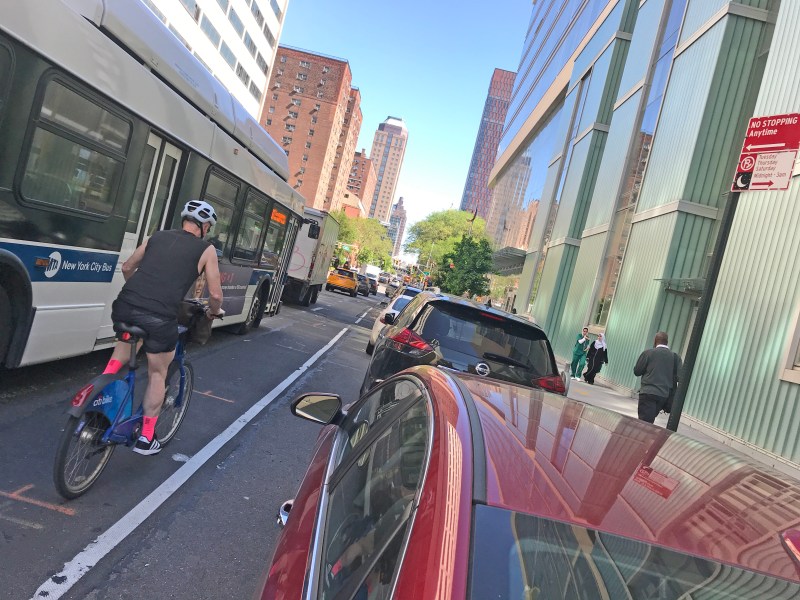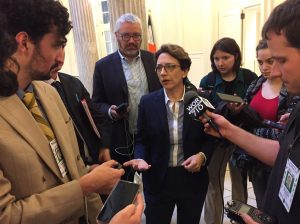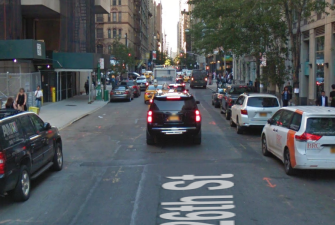DOT and NYPD: Force Drivers To Give Cyclists More Space

City transportation and police officials support a Council bill to require drivers to give cyclists at least three feet of space when passing, an effort to clarify state law that currently only requires drivers to leave “a safe distance” — and makes enforcement a challenge.
Intro 1763, by Council Member Ydanis Rodriguez would change the state law’s language to specifically require the three feet.
“The current safe passing law…is vague, and so DOT supports a clearer requirement,” Commissioner Polly Trottenberg testified on Thursday. “Currently 28 states … require at least three feet of passing distance. Doing the same under New York City local law would provide specific, easily understandable guidance to motorists and a stronger educational tool.”
The NYPD concurred.
“It would lend clarity to an otherwise vague concept,” said NYPD Transportation Bureau Chief Thomas Chan. “And would present an opportunity to publicly highlight these dangers.”
Rodriguez said his bill, inspired by a longtime Transportation Alternatives’ campaign, is needed because cyclists increasingly feel unsafe — especially in a year with 26 cyclists deaths (up from 10 in all of 2018).
I'm strongly in favor of Int 1763-2019 from @ydanis to create a "3 feet" safe passing law for #bikeNYC, however this is a weak regulation. There are other states that do better and so should we [thread]. cc: @NYCSpeakerCoJo @seancoughlinnyc https://t.co/peXGuaR603
— Jehiah (@jehiah) October 24, 2019
“It is critical that drivers give cyclists enough space for cyclists to be safe and to feel safe,” he said. “And it would give drivers and the police department a rule that is easier to observe and enforce.”
It would overwrite state vehicle traffic law 1122, which states:
The operator of a vehicle overtaking, from behind, a bicycle proceeding on the same side of a roadway shall pass to the left of such bicycle at a safe distance until safely clear thereof.
But the issue, of course, is not a specific number of feet, but safety, as Rodriguez said.
“Multi-ton cars and trucks and not bicycles are the real danger to safety on the roads,” he said in introductory remarks that called out the NYPD for what the council member believes is a lackluster enforcement effort.

His colleague Donovan Richards of Queens was even more aggressive in his opening remarks.
“The data show that the overwhelming majority of fatalities and injuries are caused by motor vehicles and I want to make sure the [NYPD] is focused on that,” he said. “And the culture of the department is one that encourages cyclist safety and that means not parking in bike lanes, treating cyclists with respect and conducting a through investigation after crashes.”
After the hearing, Chan said he saw the three-foot passing distance bill as something that would give the NYPD a new tool for charging drivers who hit cyclists.
“In situations where we may be reviewing a collision between a bicyclist and a vehicle and there’s videotape, we’ll take a look at that,” he said, suggesting drivers would be issued additional summonses.
For her part, Trottenberg said the double-digit increases in pedestrian and cyclist deaths this year is due, in part, to massive SUVs that are virtually unregulated on New York City streets.
“When an SUV has a collision, it tends to be going at a faster speed, which means [longer] stoping distance,” she said. “It’s weightier and the center of gravity is higher and when it hits a pedestrian, it is much likelier to do fatal or serious damage.”
The state Department of Motor Vehicles does charge a slightly higher registration fee for larger vehicles, but SUVs are not restricted in any way by state law.
Trottenberg did not see the three-foot-rule bill as a panacea, but does believe it will be “educational for motorists.”
“The state standard is ‘passing at a safe distance,’ and to be fair, no one quite knows what that means. When you have that three-foot-passing rule, it puts in a driver’s head, ‘I need to give cyclists a decent amount of space.'”
Streetsblog asked Trottenberg if the new three-foot-rule would encourage her to add a three-foot buffer on all painted bike lanes.
“We try to buffer bike lanes where we can,” she said. “There are some streets where it’s hard to find that distance.”
Streetsblog followed up: “But you could also come back and say that you’ll remove on-street car storage, what some people call ‘parking.'”
Trottenberg laughed (let the record show, it was a respectful laugh) and said, “Or the motorist could take a deep breath and let the cyclist get up to the intersection. And there are places where we have taken out a lane of parking to make room for cyclists, but part of that message is, ‘Motorists, if you can’t get around the cyclist safely, take a deep breath and get to the intersection.'”



